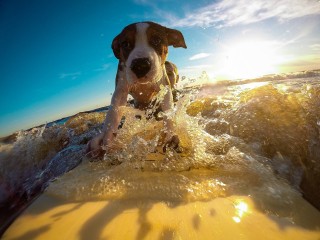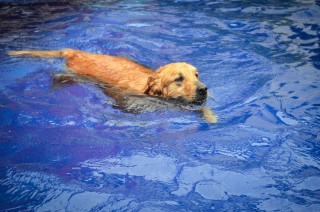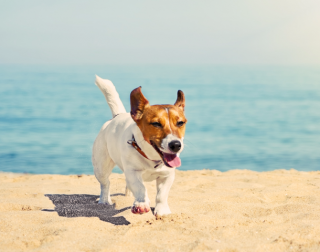We're here to help

From allergies to zinc-free suncream, we give you the lowdown on how to make sure your dog stays safe
In the summer months, temperatures regularly soar above 20C, particularly in the south of the country.
The warmer weather usually comes as welcome relief to all those fed up with wind, rain and storms. But for dogs, it’s a different story. Rising temperatures usually result in an increase in pet emergencies and, more specifically, dogs being rushed to the vet suffering potentially deadly conditions such as heat stroke and dehydration.
Here are 26 things – listed as an A to Z – dog owners should consider when temperatures soar.

A – Allergies
Just like humans, some dogs are prone to allergies during warm spells as hot weather typically sends pollen levels soaring. If your dog has itchy skin and sore, runny eyes, or any other allergy symptoms, speak to your vet about treatment options.
B – Barbecues
Believe it or not, our emergency vets see lots of barbeque-related cases – such as swallowing kebab skewers, eating cooked bones, food poisoning, and burn injuries – during the summer months. Read our advice guide on how best to keep your dog safe.
C – Curtains
Things that keep you cool will also benefit your dog – keeping curtains or blinds closed in the middle of the day will keep the sun out.
D – Dog-proof your garden
Dogs love letting off steam in the garden but just make sure your garden can cope. Choose hardy plants or shrubs that can withstand a bit of battering and make sure fencing is secure with no gaps or holes to prevent dogs escaping. Our simple tips here will hopefully help.
E – Exercise
Dogs should still be exercised during hot spells but you should never take them out when temperatures are at their peak. The ideal time for walks is early morning or late evening, as the air and ground are much cooler. This infographic explains the risks.
F – Fans
If a heat wave is predicted, consider investing in a box fan. Your dog will appreciate having somewhere cool to relax indoors especially if it’s unbearably hot outside. Click here for more tips oin keeping your dog cool.
G – Grooming
Dogs should be well groomed at all times, regardless of whether it’s hot or not, as grooming keeps them free from knots, matting and other pests. Speak to your vet about what’s best for your breed.

H – Heat stroke
Heat stroke is a significant cause of emergency admissions to our clinics in the summer months. It’s important to know the signs of this potentially fatal condition and how to prevent it happening in the first place. Our heat stroke advice guide is a great place to start.
I – Ice
Ice can be a great way to keep your dogs cool and hydrated in the warmer weather. Try adding some to their drinking water or perhaps even flavouring a few cubes with a hint of chicken stock.
J – Jags
Always make sure your dog or puppy is up to date with their recommended vaccinations. Phone your vet for advice if you’re uncertain about which ones your dog needs.
K – Keep out
It’s worth bearing in mind that enclosed spaces such as greenhouses and conservatories can get dangerously hot even when the weather just feels warm. In the summer your best bet is to keep dogs out, especially during the day.
L – Licking can kill
Dogs are curious animals but this can get them into trouble. Dogs who come across toads, for example, will often try to lick them. Toads respond by releasing poisonous venom from glands on their skin which can make dogs very sick.
M – Microchipping
Microchipping is now a legal requirement for dogs and you can be fined up to £500 if you ignore this. Your dog must also wear a collar with your name and address inscribed on it or on an attached tag. This is especially important if you’re planning on taking your dog on holiday.
N – No long car rides
Try to avoid taking your dog on a long car journey when it’s hot. Cars can heat up very quickly even when they’re moving and our vets see countless cases of dogs suffering heat stroke because they’ve been in a hot car too long. This infographic explains the signs to look out for.

O – Obese dogs beware
Larger dogs, and particularly those who are obese, are more likely to experience heat stroke so keep a very close eye on them during hot weather. You’ll find more info on how to care for an overweight dog here.
P – Paws
On warm days, road and pavement surfaces can heat up to a staggering 62C (143F). At these temperatures, your dog could severely burn their paws. Before taking them out for a walk place the back of your hand on the surface for seven seconds. If you struggle to hold it down, it’s too hot to walk your dog. Read more here.
Q – Quaff plenty water
It’s vitally important your dog stays hydrated in the heat. Always ensure they have access to fresh drinking water and please, please remember to pack water and a bowl whenever you’re out for a walk to ensure they don’t dehydrate.
R – Rest
Make sure your dog doesn’t play too hard in the warm summer sun. It’s imperative they take regular breaks when exercising, especially if they have underlying breathing problems or are overweight.
S – Sand
If you’re a regular beachgoer it’s worth remembering your dog may ingest sand through digging or repeatedly picking up sandy balls and toys. This can cause a blockage in the intestine, which is called sand impaction.
T – T-shirts
As silly as it sounds, putting a damp t-shirt on your dog can help cool them down while also protecting them from sunburn. Make sure the t-shirt isn’t too tight though.

U – Umbrella
If there’s no shade in your garden, consider investing in an umbrella big enough for your dog to lie under in the warm weather. Your dog will be pawfully thankful!
V – Vets
Make sure you store the number of your daytime vet and your nearest Vets Now pet emergency service because you never know when your dog might get injured or fall ill.
W – Warning signs
As a dog owner, there’s every chance you’ll know instinctively when something’s not right. But it’s worth studying some of the warning signs associated with common conditions such as heat stroke. Our advice section is a great place to start.
X – Xylitol
Xylitol is a sugar substitute that’s contained in lots of products, including some baking and pudding mixes, cakes and buns, sugar-free chewing gum and mints. But it’s highly toxic to dogs. If you’re going on a picnic be careful not to let your dog near any foods containing this ingredient.
Y – You
According to research, 48% of pet owners wouldn’t know what to do in an emergency (and 52% aren’t insured for such an eventuality). As a dog owner, you are the only person who can change this. Read our guide on what to do in an emergency to make sure you’re not part of the 48%.
Z – Zinc-free suncream
Just like humans, dogs skin can burn very easily. This can be avoided by applying a zinc oxide-free suncream to their ears, paws, face and stomach.
